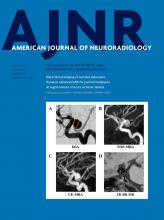Index by author
Radmanesh, A.
- You have accessThe Continued Rise in Professional Use of Social Media at Scientific Meetings: An Analysis of Twitter Use during the ASNR 2018 Annual MeetingG. D'Anna, M.M. Chen, J.L. McCarty, A. Radmanesh and A.L. KotsenasAmerican Journal of Neuroradiology June 2019, 40 (6) 935-937; DOI: https://doi.org/10.3174/ajnr.A6064
Rafailidis, D.
- Extracranial VascularYou have accessAn Ultrasonographic Multiparametric Carotid Plaque Risk Index Associated with Cerebrovascular Symptomatology: A Study Comparing Color Doppler Imaging and Contrast-Enhanced UltrasonographyV. Rafailidis, I. Chryssogonidis, C. Xerras, E. Grisan, G.-A. Cheimariotis, T. Tegos, D. Rafailidis, P.S. Sidhu and A. Charitanti-KouridouAmerican Journal of Neuroradiology June 2019, 40 (6) 1022-1028; DOI: https://doi.org/10.3174/ajnr.A6056
Rafailidis, V.
- Extracranial VascularYou have accessAn Ultrasonographic Multiparametric Carotid Plaque Risk Index Associated with Cerebrovascular Symptomatology: A Study Comparing Color Doppler Imaging and Contrast-Enhanced UltrasonographyV. Rafailidis, I. Chryssogonidis, C. Xerras, E. Grisan, G.-A. Cheimariotis, T. Tegos, D. Rafailidis, P.S. Sidhu and A. Charitanti-KouridouAmerican Journal of Neuroradiology June 2019, 40 (6) 1022-1028; DOI: https://doi.org/10.3174/ajnr.A6056
Raymond, C.
- Adult BrainOpen AccessAssociation between Tumor Acidity and Hypervascularity in Human Gliomas Using pH-Weighted Amine Chemical Exchange Saturation Transfer Echo-Planar Imaging and Dynamic Susceptibility Contrast Perfusion MRI at 3TY.-L. Wang, J. Yao, A. Chakhoyan, C. Raymond, N. Salamon, L.M. Liau, P.L. Nghiemphu, A. Lai, W.B. Pope, N. Nguyen, M. Ji, T.F. Cloughesy and B.M. EllingsonAmerican Journal of Neuroradiology June 2019, 40 (6) 979-986; DOI: https://doi.org/10.3174/ajnr.A6063
Riechelmann, H.
- FELLOWS' JOURNAL CLUBHead & NeckYou have accessReadout-Segmented Echo-Planar DWI for the Detection of Cholesteatomas: Correlation with Surgical ValidationN. Fischer, V.H. Schartinger, D. Dejaco, J. Schmutzhard, H. Riechelmann, M. Plaikner and B. HenningerAmerican Journal of Neuroradiology June 2019, 40 (6) 1055-1059; DOI: https://doi.org/10.3174/ajnr.A6079
Readout-segmented echo-planar (RESOLVE)-DWI is a new alternative technique for obtaining DWI with high quality, delivering sharp images at high spatial resolution and reduced slice thickness. Fifty patients with chronic otitis media who underwent MR imaging before an operation of the middle ear were included. The MR imaging protocol consisted of axial and coronal readout-segmented echo-planar DWI with b-values of 0 and 1000 s/mm2 and 3-mm slice thickness. The readout segmented echo-planar diffusion-weighted images were fused with standard T2-weighted sequences for better anatomic assignment. Readout-segmented echo-planar DWI detected 22 of the 25 cases of surgically proved cholesteatoma. It has an accuracy of 92%, a sensitivity of 88%, a specificity of 96%, a positive predictive value of 96%, and a negativepredictive value of 89%. Readout-segmented echo-planar DWI is a promising and reliable MR imaging sequence for the detection and exclusion of cholesteatoma.
Rieger, A.
- EDITOR'S CHOICEAdult BrainYou have accessSusceptibility-Weighted MR Imaging Hypointense Rim in Progressive Multifocal Leukoencephalopathy: The End Point of Neuroinflammation and a Potential Outcome PredictorM.M Thurnher, J. Boban, A. Rieger and E. GelpiAmerican Journal of Neuroradiology June 2019, 40 (6) 994-1000; DOI: https://doi.org/10.3174/ajnr.A6072
This retrospective study included 18 patients with a definite diagnosis of progressive multifocal leukoencephalopathy. Ten patients were HIV-positive, 3 patients had natalizumab-associated PML, 1 patient had multiple myeloma, 3 patients had a history of lymphoma, and 1 was diagnosed with acute myeloid leukemia. Patients were divided into short- (up to 12 months) and long-term (>12 months) survivors. A total of 93 initial and follow-up MR imaging examinations were reviewed. On SWI, the presence and development of a hypointense rim at the periphery of the PML lesions were noted. A postmortem histologic examination was performed in 2 patients: A rim formed in one, and in one, there was no rim. A total of 73 progressive multifocal leukoencephalopathy lesions were observed. In 13 (72.2%) patients, a well-defined thin, linear, hypointense rim at the periphery of the lesion toward the cortical side was present, while in 5 (27.8%) patients, it was completely absent. All 11 long-term survivors and 2 short-term survivors presented with a prominent SWI-hypointense rim. The thin, uniformly linear, gyriform SWI-hypointense rim in the paralesional U-fibers in patients with definite PML might represent an end point stage of the neuroinflammatory process in long-term survivors.
Rieter, W.J.
- PediatricsYou have accessRadiation Dose and Image Quality in Pediatric Neck CTS.V. Tipnis, W.J. Rieter, D. Patel, S.T. Stalcup, M.G. Matheus and M.V. SpampinatoAmerican Journal of Neuroradiology June 2019, 40 (6) 1067-1073; DOI: https://doi.org/10.3174/ajnr.A6073
Roh, H.G.
- EDITOR'S CHOICEAdult BrainOpen AccessA Novel Collateral Imaging Method Derived from Time-Resolved Dynamic Contrast-Enhanced MR Angiography in Acute Ischemic Stroke: A Pilot StudyH.G. Roh, E.Y. Kim, I.S. Kim, H.J. Lee, J.J. Park, S.B. Lee, J.W. Choi, Y.S. Jeon, M. Park, S.U. Kim and H.J. KimAmerican Journal of Neuroradiology June 2019, 40 (6) 946-953; DOI: https://doi.org/10.3174/ajnr.A6068
The purpose of this study was to introduce a multiphase MRA collateral map derived from time-resolved dynamic contrast-enhanced MRA and to verify the value of the multiphase MRA collateral map in acute ischemic stroke by comparing it with the multiphase collateral imaging method (MRP collateral map) derived from dynamic susceptibility contrast-enhanced MR perfusion. The authors generated collateral maps using dynamic signals from dynamic contrast-enhanced MRA and DSC-MRP in 67 patients using a Matlab-based in-house program and graded the collateral scores of the multiphase MRA collateral map and the MRP collateral map independently. Interobserver reliabilities and intermethod agreement between both collateral maps for collateral grading were tested. The interobserver reliabilities forcollateral grading using multiphase MRA or MRP collateral maps were excellent. They conclude that the dynamic signals of dynamic contrast-enhanced MRA can generate multiphasecollateral images and show the possibility of the multiphase MRA collateral map as a useful collateral imaging method in acute ischemic stroke.








